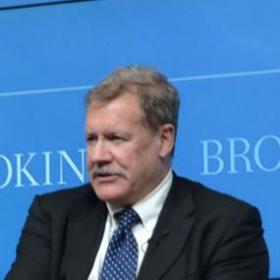
Austin Writes for New Europe on Russia's Naval Build-Up
Plans for a Russian naval renaissance are part of President Putin's broader strategy to gain geopolitical advantage in the international system, according to Austin.
Read the full piece here on New Europe.
Russia’s Naval Dream
With immaculate timing, given the crisis in Crimea and the rest of Ukraine, Russia last week announced plans to rebuild a global naval presence. This follows an announcement in January that the navy will take delivery of 40 new ships and other vessels this year (though most are smaller ship classes).
One of the new units to be commissioned this year is a ballistic missile nuclear-powered submarine named for the ruler of Kievan Rus’ in the 11th and 12th centuries, known now in Russian as Vladimir Monomakh. One millennium later, another Vladimir, this one a Putin, sees the history of Russia as inextricably tied to and deriving from that state of Rus’, first established in Kyiv (Kiev). For him the chain of political association is unbroken, notwithstanding the the break-up of the Soviet Union. In 2005, Putin declared this to be “the greatest geopolitical catastrophe” of the 20th century.
Putin has masterminded a naval renaissance in his country beginning in the middle of the last decade. He knows he cannot reverse the catastrophe, but he is determined to redress its effects as best he can, and this includes maintaining intimate political relations with Ukraine. The task remains not only incomplete but is now in serious crisis.
On 26 February, the Russian Defense Minister, Sergei Shoigu, declared his country’s plans to establish a number of new foreign naval bases and to set up access rights elsewhere. His list includes Vietnam, Cuba, Venezuela, Nicaragua, the Seychelles and Singapore. By October 2103, Russian port visits that year were up 35 percent compared with the previous year, according to Tom Fedyszyn writing in The National Interest in December. This plan for a global naval presence gives a clear pointer to the continuing high priority that Russia places on control of the naval base in Sevastopol in Crimea.
The naval renaissance also includes an expansion of Russian naval basing and maritime air patrols in the Arctic, measures which were also announced in January this year. The move was a response to an order from President Putin in December 2013. One week after that order, the Deputy Prime Minister responsible for defence industry, Dmitry Rogozin, announced plans to expand ship-building capabilities in the Russian Far East city of Khabarovsk. He said that Russia had a geopolitical duty to respond to discussions in NATO beginning in 2009 to beef up its Arctic naval presence.
As Fedyszyn notes, the naval expansion is not without its growing pains, and the Russian navy remains a pale imitation of the Soviet navy in its 1980s heyday. But Russia is not counting on matching US naval capability any time soon. It is intent on a return to classic geopolitics. The naval expansion is just one sign of the intent.
Analysts in China understand this well. Writing in Global Times on 1 August 2013, Retired Rear Admiral Yang Yi made a plea for Chinese naval development to be based on a benchmark of the naval power of Russia. He said that Russia has the second largest navy in the world and China should aspire to emulate it.
Russia, like China, and possibly relying in part on the latter’s naval power, believes that it can gain new geopolitical leverage from its own maritime renaissance. More importantly, Russia, like China, is determined to press for new geopolitical power. This is not the diplomacy of peaceful coexistence or common security. It is a return to zero-sum politics. This new Russian vision may be a pipe-dream, but we have to accept that this is how Russia’s leaders are thinking. However the Ukraine crisis plays out, Russia will not be abandoning its new “naval dream” anytime soon. Sevastopol is part of that dream.
Photo Credit: Official U.S. Navy Imagery

